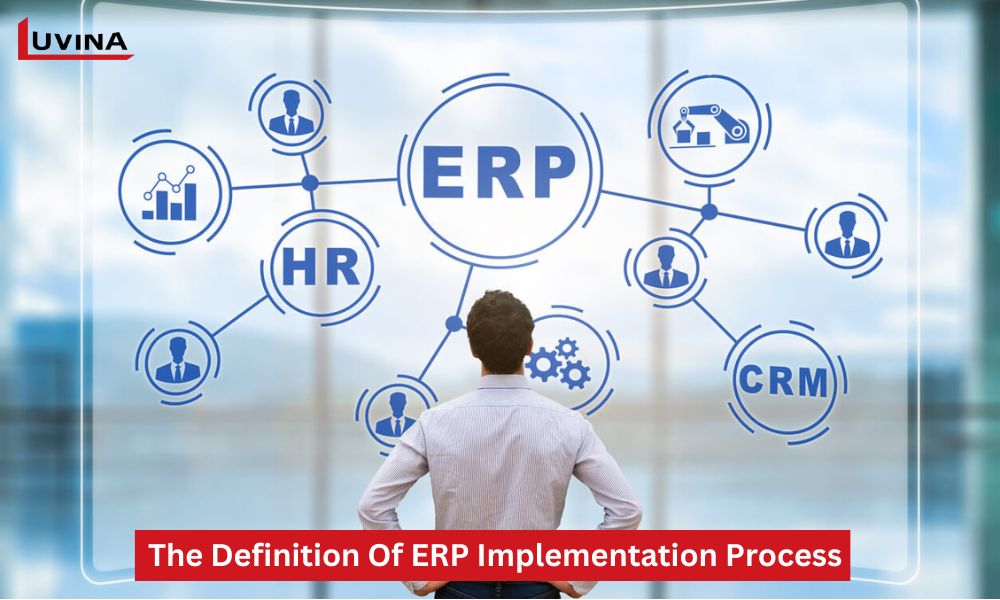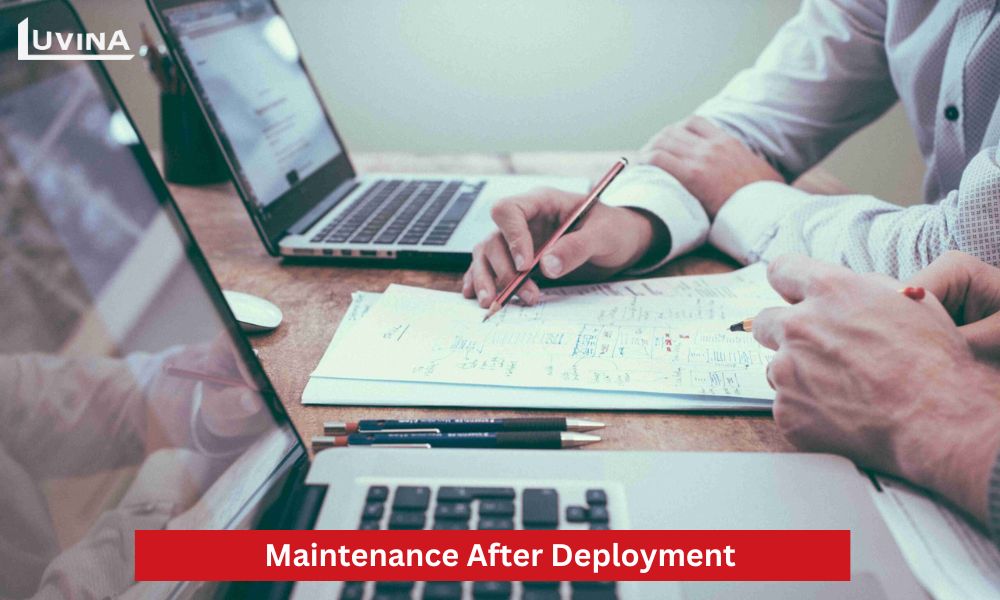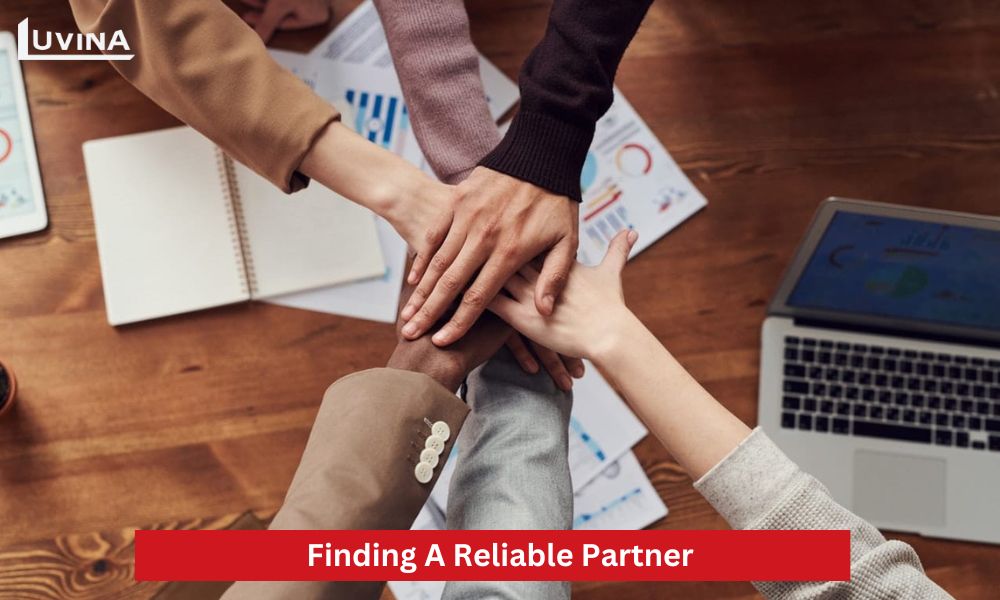Understanding the ERP Implementation Life Cycle is a way for businesses to optimize the benefits of this system. Implementing ERP will impact various parts of the business. Planning for ERP deployment has never been an easy task. To avoid future issues, continue reading this article to explore the 9 essential stages of ERP implementation and important considerations when applying this system.
What is the ERP Implementation Process?
The ERP Implementation Life Cycle (ERP implementation process) is the process of planning, designing, and deploying an ERP system. Its complexity depends on the scale and complexity of the business. However, the basic stages typically include planning, analysis, design, deployment, and maintenance.

The ERP implementation process usually takes place for 6 to 12 months. For a smooth ERP deployment, businesses need to plan and implement it step by step carefully. The success of ERP implementation steps is crucial for the new ERP system to streamline business operations and reduce unnecessary costs.
9 Important ERP Implementation Life Cycle Steps
The stages of the ERP Implementation Life Cycle will depend on each company. However, generally, the ERP implementation process will include the following 9 steps:
Step 1: Planning
The ERP implementation process needs to be carefully planned to avoid encountering numerous issues later on. The planning phase will involve defining goals, selecting appropriate resources, choosing suitable experts, budget estimation, and more.
Step 2: Selecting ERP Package
Next, the business must choose suitable ERP software based on its needs and scale. This is one of the most crucial stages in the ERP implementation life cycle. The success or failure of the project depends on this phrase. The best ERP package is not necessarily the most expensive one but the most suitable for the business.
Step 3: Analysis GAP
GAP analysis is also a crucial step in ERP system implementation. During this stage, you need to compare the business’s current operations with the functions that the ERP package will support. According to research, even the best ERP packages can only meet 80% to 85% of the required business functions. Therefore, GAP analysis helps identify the key functions that need emphasis in your ERP system.
Step 4: Re-engineering
This is the adjustment step, redesigning business processes to incorporate new improvements. The factors adjusted in this process will be determined based on the planning and GAP analysis steps.

Step 5: Customization
This is the first step in turning the ERP system into the “unique weapon” of each business. The solutions provided by ERP must align with the goals and needs of the company.
Step 6: Implementation team training
After going through the above steps, at this stage, the implementation team knows how to implement the system. However, since ERP is a new system, the business needs to train its employees to use it.
Step 7: Testing
The testing step in the ERP implementation life cycle is the phase where any errors (if any) are identified and addressed before putting the system into operation. The testing phase may occur multiple times throughout the development process. The development team can continuously test and fix errors until completing one module before moving on to the next; or test one module in parallel with developing another module.
Step 8: Go-Live & Deployment
After the ERP system has been tested, all data will be converted to be introduced into the new system. This stage is referred to as “going live.” When the ERP system is officially operational, the old system will be decommissioned.
Step 9: Operation & Maintenance
Maintenance is the final stage in the ERP implementation life cycle. Once the system is in operation, specialists still need to update and address any issues that may arise regularly. Employees of the business also need to learn how to maintain the system.
>> Also read: 5 Tips to Implement ERP System Maintenance

The Risks of Neglecting an ERP Solution
By integrating all data and functions onto a centralized platform, ERP will facilitate better collaboration among departments within the business, and streamline operations. Conversely, if you don’t implement an ERP solution, your business may encounter the following risks during its operations:
Disparate operational processes
Different departments within a business usually use separate software. For example, the accounting department might use one software, while the marketing department uses another. However, this lack of integration leads to disconnected workflows within the organization. In contrast, with ERP, a business only needs a single platform for interaction and information retrieval.
Difficult decision-making
An ERP system is necessary for businesses to avoid many issues with data storage; departments also can’t effectively communicate and share information. Therefore, it’s easy to make mistakes that affect business operations. The ERP Implementation Life Cycle will help create a centralized data platform, improve departmental communication, and lead to more informed decision-making.
Too many software systems
Before having ERP, businesses surely had at least 1-2 outdated software systems that consumed a lot of money. Some old software had to be customized with third-party utilities. Meanwhile, an ERP system can replace numerous old software systems, making business operations more efficient and optimizing costs.
Time-consuming administrative procedures
Many businesses in the market still maintain manual tasks in departments such as accounting, sales, customer relations, etc. This causes business process handling to be significantly delayed. Moreover, you won’t have a complete picture of the company’s situation without a centralized data storage platform.
Time wasted gathering information, and data
When using old, outdated software systems, you’ll encounter many difficulties in consolidating, organizing, reporting, and using data. Meanwhile, the ERP implementation process will help you gain a comprehensive view of your business to maximize profits and seize new business opportunities.
>> Also read: Everything You Need for a Successful ERP Data Migration
Inventory management errors
For manufacturing and sales businesses, using manual spreadsheets and files makes inventory management inefficient. Meanwhile, the supply chain needs constant access to information about suppliers, raw materials, and inventory ratios. Management becomes easier and more effective when inventory information is integrated with customer, sales, and production data in ERP.
The IT team faces many difficulties
The more systems and software a business has to maintain, the more challenges its IT team encounters. They constantly need to quickly update upgrades, add features, and deal with various issues with different software. Mistakes can occur during this process. If the ERP Implementation Life Cycle is carried out and a single centralized system is created, the IT team can focus on more important tasks.
Unable to access information on mobile devices
Modern workers tend to work remotely often, meaning they need to access information remotely using mobile devices. Being unable to access information slows down work progress, and employees find it difficult to make informed decisions. However, an ERP system can provide applications that work well on internet-enabled devices.
Difficulty complying with legal regulations
Many businesses today are constrained by data security requirements. If operating manually, businesses will inevitably make mistakes in enforcing these regulations. ERP software will track and accurately report the necessary information for businesses to comply with local and international regulations.

>> Also read: Best ERP Implementation Strategy
ERP Implementation Best Practices
To ensure the smooth operation of ERP software, you need not only a well-organized ERP implementation life cycle with each step but also the best practices for each stage. If you plan to develop an ERP system for your business, check out some of the best practices below.
1. Clear definition of requirements, goals, and KPIs
Before proceeding with the ERP Implementation Life Cycle, you need to clearly define what you want to achieve after implementing ERP. Your requirements must align with your business goals. Once requirements are identified, setting KPIs will help you measure the effectiveness of the ERP implementation process.
2. Planning is crucial
You shouldn’t rush during the initial planning phase because this is the foundation stage for the entire project. Detailed planning will help you allocate an adequate budget, personnel, and time for the tasks to be done.
Additionally, after the software is completed, you also need to plan change management to help employees adapt to the new system faster. Identify from the beginning which departments will be affected by the system change, communicate with relevant parties, and prepare for training.
3. Developing training and support programs
After deploying the system, you need to have a training and support program for your staff so they know how to troubleshoot issues or update as needed. Each team of employees needs its own training program, for example, a project team training program, or an IT specialist team training program. You also need to develop a training program for new employees in advance. Employees must feel comfortable using the system for it to be effective.

4. Regularly gather feedback from end users
Throughout the entire ERP implementation life cycle, be sure to collect feedback from end users (business employees) to understand their learning and interaction preferences. This feedback will also help the system address users’ real needs, identify issues, and make improvements for the future.
5. Check data before conversion
Before transferring all data to the new system, you need to assess the accuracy and completeness of the data to avoid transferring outdated or unnecessary data. The quality of data will affect all ERP implementation steps. Building an ERP system is an opportunity for you to clean up and rationalize your business data. Format data consistently, and remove old and inaccurate data before proceeding with the conversion.
6. Accepting failures during implementation
Errors in the ERP implementation life cycle are inevitable. Of course, most businesses will try to prevent these mistakes because no one wants to spend millions of dollars only to receive an ERP system that cannot be used. However, accept that errors may occur during implementation. This will help the business reduce unrealistic expectations and be prepared to address potential issues.
7. Communication is key
Throughout the ERP implementation process, the development team should regularly communicate internally with the business about the reasons for implementing ERP, as well as the goals and benefits of the system. Regular communication will allow the development team to understand user issues before and after system implementation.
8. Choosing a reliable partner
On the business side, you need a representative team of individuals who understand the business processes to help establish goals, requirements, and KPIs, and ensure that the ERP project stays on track. Additionally, you also need to choose the right ERP implementation company, which can increase the system’s success rate.

With an experienced team of developers, Luvina is a trusted partner that can help businesses build a new ERP system or adjust existing systems through custom integration. Offering a range of high-quality solutions such as GRANDIT, DYNAMICAX, WORKDAY, SAP, and ORACLE, Luvina supports businesses in improving their business processes effectively.
Luvina commits to providing:
– The highest quality services have ISO 9001 and CMMI Level 3 certifications.
– Continuous support and assistance 24/7 regardless of time zone, in both English and Japanese.
– Scalability of the IT team to meet project requirements.
Luvina is always ready to provide solutions tailored to the specific needs of each business. Contact us for a free consultation today!
Conclusion
The ERP Implementation Life Cycle requires businesses to invest time, money, and resources. However, the results that businesses receive will be truly worthwhile. Creating a detailed plan step by step while continuously optimizing system functionality after deployment is the key to the long-term success of an ERP system.
Related Posts:









Read More From Us?
Sign up for our newsletter
Read More From Us?
Sign up for our newsletter